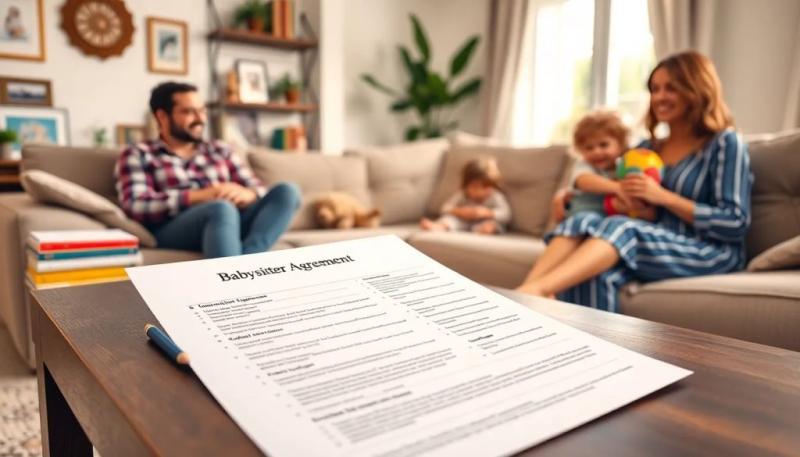Creating a babysitting contract is an essential step for parents hiring a caregiver. This formal agreement can help establish clear expectations and responsibilities for both parties. Understanding how to write clear babysitter agreements is crucial to avoiding misunderstandings and ensuring a smooth childcare experience.
A well-structured babysitting contract not only protects the parents but also provides the babysitter with clarity regarding their role and responsibilities. In this article, we will explore various aspects of babysitting contracts, including their importance, key components, and tips for drafting them effectively.
Understanding the need for a babysitting contract
A babysitting contract serves multiple purposes. First and foremost, it establishes clear communication between parents and caregivers. By documenting the expectations, both parties can avoid potential conflicts down the line.
Furthermore, a written agreement can help protect both sides in case any disputes arise. For example, if there are disagreements about payment or responsibilities, having a contract can serve as a reference to resolve these issues effectively.
Moreover, the importance of a written babysitting agreement increases significantly for long-term arrangements. It provides a professional framework, making the relationship more formal and respectful.
What should your babysitter contract include?
When drafting a babysitter contract, there are several key components that must be included. These components provide a comprehensive overview of the caregiver's responsibilities and the parents' expectations.
- Contact information: Include the names, addresses, and phone numbers of both the parents and the babysitter.
- Work schedule: Outline the days and hours the babysitter is expected to work.
- Compensation: Clearly state the payment rate and how often the babysitter will be paid.
- Caregiver responsibilities: List specific duties the babysitter is expected to perform, such as meal preparation, homework help, and bedtime routines.
- Emergency procedures: Include guidelines on how to handle emergencies, including contact numbers for family members and emergency services.
By including these elements, parents can ensure that their babysitting contract is thorough and addresses all necessary areas. Additionally, being transparent about each component helps build trust between parents and caregivers.
How to write clear babysitter agreements template?
Creating a template for a babysitting agreement can significantly simplify the process of drafting individual contracts. Start by using a clear structure that includes headings for each section, making it easy to fill in specific details.
When developing your template, consider including spaces for the following:
- Date of the agreement
- Duration of the service
- Specific duties and expectations
- Payment terms and methods
- Cancellation or termination clauses
Having a babysitting template allows parents to customize the agreement according to their unique needs while ensuring that all essential aspects are covered. This can save time and reduce the likelihood of overlooking important details.
When should you use a babysitting contract?
A babysitting contract is particularly important for regular or long-term arrangements. If you are hiring a babysitter for a one-time occasion, a verbal agreement may suffice. However, for ongoing services, a written contract is highly recommended.
Additionally, the use of a contract is vital when hiring someone who is not a family member. This helps to legally protect both the parents and the caregiver by clarifying expectations and responsibilities.
Ultimately, understanding how to draft an effective babysitter agreement ensures both the parents and the babysitter are on the same page, which fosters a more positive working relationship.
What are the key components of a babysitting contract?
Besides the general components discussed earlier, there are several other important elements that should be included in a babysitting contract. These can enhance clarity and help prevent misunderstandings.
- Special needs: If any children have special requirements, these should be detailed in the contract.
- Reimbursements: Outline any potential reimbursements for supplies or transportation incurred by the babysitter.
- House rules: Specify any household policies the babysitter should be aware of, such as screen time limits or dietary restrictions.
By incorporating these components, parents can create a comprehensive babysitting contract that ensures all parties understand their roles and obligations. This level of detail promotes a smoother and more professional working atmosphere.
How to discuss a babysitting contract with your caregiver?
Having an open dialogue with your babysitter about the contract is essential for ensuring mutual understanding. Begin the conversation by explaining the purpose of the contract and how it benefits both parties.
Encourage the babysitter to ask questions and express any concerns they may have. This can help to address potential issues before they escalate.
Additionally, be prepared to negotiate certain terms of the contract, such as compensation or work schedules. By approaching the discussion with flexibility, both parties can reach an agreement that works for everyone.
What happens if you skip the babysitting contract?
Failing to create a babysitting contract can lead to various complications. Without a formal agreement, misunderstandings regarding expectations and responsibilities may arise, potentially resulting in conflicts.
Moreover, in the absence of a contract, it can be challenging to enforce any agreements made verbally. This lack of documentation may lead to disputes over payment or duties, which can damage the relationship between parents and caregivers.
In summary, neglecting a written agreement may expose both parties to unnecessary risks. It is always a wise decision to establish a formal babysitting contract to protect your interests and maintain a harmonious working relationship.
Related questions about babysitting agreements
How to write a contract for babysitting?
To write a contract for babysitting, begin by outlining the essential components, such as contact information, work schedules, compensation details, and caregiver responsibilities. Ensure that the language is clear and unambiguous to avoid misunderstandings.
It is also helpful to review the contract with the babysitter to address any potential concerns. This ensures that both parties are comfortable with the terms and can reference the contract should any issues arise.
How much to pay a babysitter for 2.5 hours?
The pay for a babysitter can vary widely based on location, experience, and the specific tasks required. On average, babysitters may charge between $10 to $20 per hour. For 2.5 hours, you can expect to pay between $25 to $50, depending on these factors.
It’s important to discuss payment terms during the contract negotiation phase to ensure both parties agree on a fair rate.
How to write a simple contract example?
A simple contract example might include the following sections: date of the agreement, names and contact information of both parties, payment terms, working hours, and specific duties of the babysitter. Make sure to keep the language straightforward and easy to understand.
For instance, a simple clause might read: "The babysitter will provide care for up to three children, including meal preparation and bedtime routines, from 5 PM to 10 PM for $15 per hour."
How to write a letter stating you babysit?
When writing a letter to state that you babysit, include your name, contact information, and a brief description of your experience. Mention the types of services you offer, such as part-time or full-time care, and any special skills like first aid training.
A straightforward approach could be: "Dear [Recipient's Name], I am offering babysitting services for families in our community. With [number] years of experience caring for children, I provide a safe and nurturing environment. Please feel free to contact me at [phone number] for more details."




